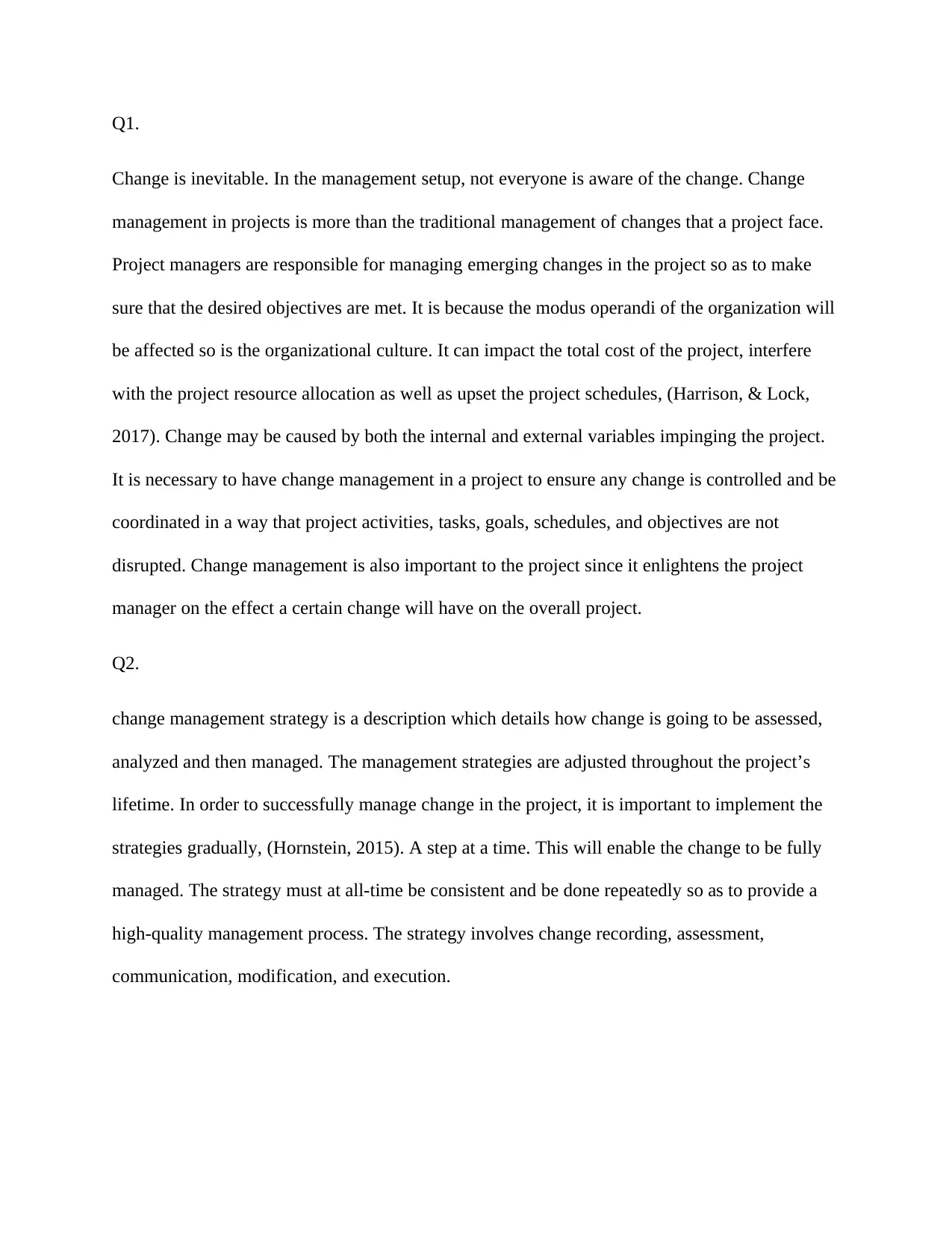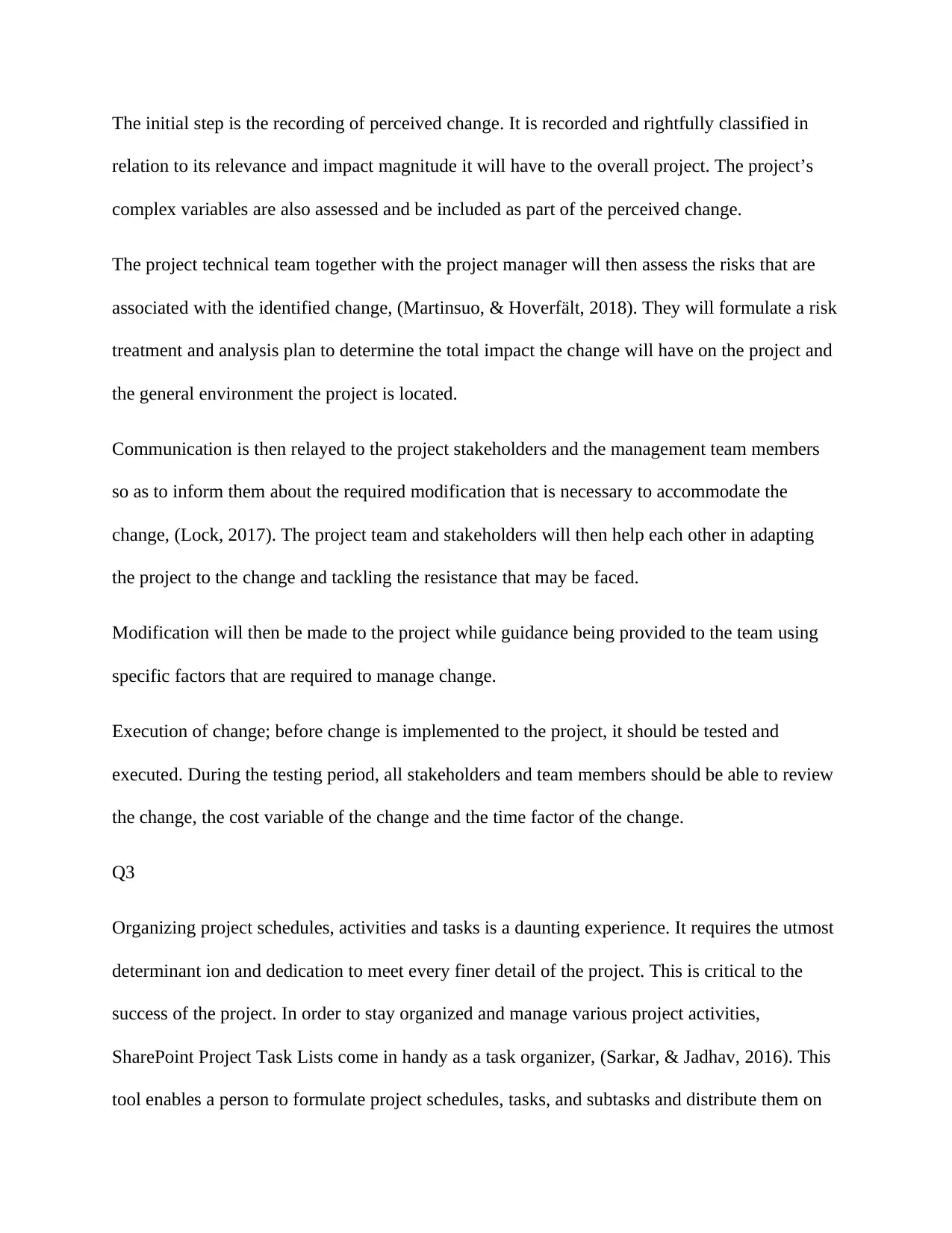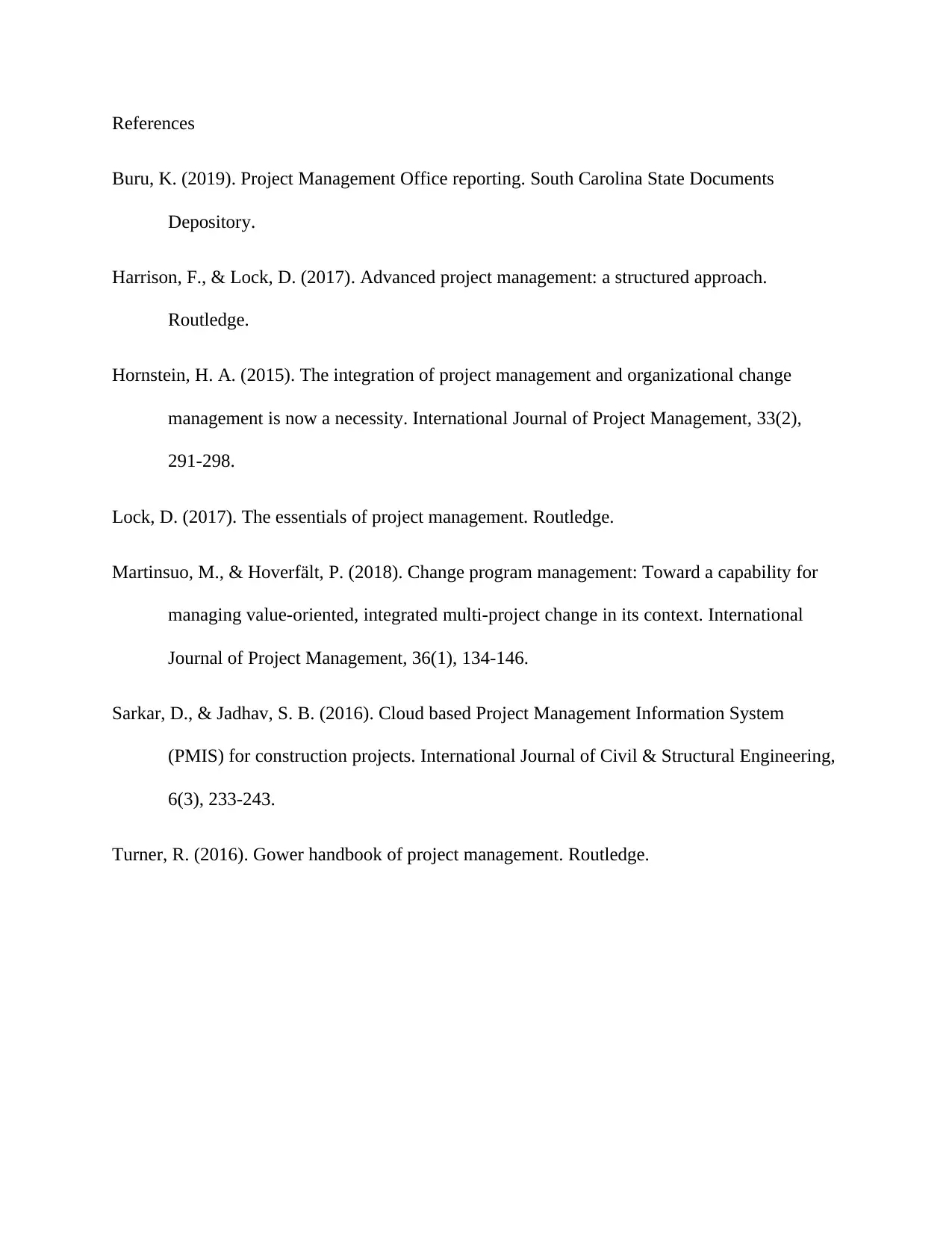Project Execution and Control: Change Management Report - PROJ6003
VerifiedAdded on 2022/09/28
|5
|1050
|23
Report
AI Summary
This report addresses the critical aspects of change management within project execution and control. It begins by emphasizing the inevitability of change in project environments, the role of project managers in managing these changes, and the potential impacts on project costs, resource allocation, and schedules. The report then details a change management strategy, outlining a step-by-step approach that includes recording, assessing, communicating, modifying, and executing changes. It highlights the use of tools like SharePoint Project Task Lists for organizing tasks, managing project activities, and tracking changes. Furthermore, the report discusses the change control process, emphasizing the importance of tools for documenting and monitoring change requests, and simplifying the change tracking process. References to relevant literature support the key concepts and strategies presented.

Student’s Name
Institution
Tutor
Date
Institution
Tutor
Date
Paraphrase This Document
Need a fresh take? Get an instant paraphrase of this document with our AI Paraphraser

Q1.
Change is inevitable. In the management setup, not everyone is aware of the change. Change
management in projects is more than the traditional management of changes that a project face.
Project managers are responsible for managing emerging changes in the project so as to make
sure that the desired objectives are met. It is because the modus operandi of the organization will
be affected so is the organizational culture. It can impact the total cost of the project, interfere
with the project resource allocation as well as upset the project schedules, (Harrison, & Lock,
2017). Change may be caused by both the internal and external variables impinging the project.
It is necessary to have change management in a project to ensure any change is controlled and be
coordinated in a way that project activities, tasks, goals, schedules, and objectives are not
disrupted. Change management is also important to the project since it enlightens the project
manager on the effect a certain change will have on the overall project.
Q2.
change management strategy is a description which details how change is going to be assessed,
analyzed and then managed. The management strategies are adjusted throughout the project’s
lifetime. In order to successfully manage change in the project, it is important to implement the
strategies gradually, (Hornstein, 2015). A step at a time. This will enable the change to be fully
managed. The strategy must at all-time be consistent and be done repeatedly so as to provide a
high-quality management process. The strategy involves change recording, assessment,
communication, modification, and execution.
Change is inevitable. In the management setup, not everyone is aware of the change. Change
management in projects is more than the traditional management of changes that a project face.
Project managers are responsible for managing emerging changes in the project so as to make
sure that the desired objectives are met. It is because the modus operandi of the organization will
be affected so is the organizational culture. It can impact the total cost of the project, interfere
with the project resource allocation as well as upset the project schedules, (Harrison, & Lock,
2017). Change may be caused by both the internal and external variables impinging the project.
It is necessary to have change management in a project to ensure any change is controlled and be
coordinated in a way that project activities, tasks, goals, schedules, and objectives are not
disrupted. Change management is also important to the project since it enlightens the project
manager on the effect a certain change will have on the overall project.
Q2.
change management strategy is a description which details how change is going to be assessed,
analyzed and then managed. The management strategies are adjusted throughout the project’s
lifetime. In order to successfully manage change in the project, it is important to implement the
strategies gradually, (Hornstein, 2015). A step at a time. This will enable the change to be fully
managed. The strategy must at all-time be consistent and be done repeatedly so as to provide a
high-quality management process. The strategy involves change recording, assessment,
communication, modification, and execution.

The initial step is the recording of perceived change. It is recorded and rightfully classified in
relation to its relevance and impact magnitude it will have to the overall project. The project’s
complex variables are also assessed and be included as part of the perceived change.
The project technical team together with the project manager will then assess the risks that are
associated with the identified change, (Martinsuo, & Hoverfält, 2018). They will formulate a risk
treatment and analysis plan to determine the total impact the change will have on the project and
the general environment the project is located.
Communication is then relayed to the project stakeholders and the management team members
so as to inform them about the required modification that is necessary to accommodate the
change, (Lock, 2017). The project team and stakeholders will then help each other in adapting
the project to the change and tackling the resistance that may be faced.
Modification will then be made to the project while guidance being provided to the team using
specific factors that are required to manage change.
Execution of change; before change is implemented to the project, it should be tested and
executed. During the testing period, all stakeholders and team members should be able to review
the change, the cost variable of the change and the time factor of the change.
Q3
Organizing project schedules, activities and tasks is a daunting experience. It requires the utmost
determinant ion and dedication to meet every finer detail of the project. This is critical to the
success of the project. In order to stay organized and manage various project activities,
SharePoint Project Task Lists come in handy as a task organizer, (Sarkar, & Jadhav, 2016). This
tool enables a person to formulate project schedules, tasks, and subtasks and distribute them on
relation to its relevance and impact magnitude it will have to the overall project. The project’s
complex variables are also assessed and be included as part of the perceived change.
The project technical team together with the project manager will then assess the risks that are
associated with the identified change, (Martinsuo, & Hoverfält, 2018). They will formulate a risk
treatment and analysis plan to determine the total impact the change will have on the project and
the general environment the project is located.
Communication is then relayed to the project stakeholders and the management team members
so as to inform them about the required modification that is necessary to accommodate the
change, (Lock, 2017). The project team and stakeholders will then help each other in adapting
the project to the change and tackling the resistance that may be faced.
Modification will then be made to the project while guidance being provided to the team using
specific factors that are required to manage change.
Execution of change; before change is implemented to the project, it should be tested and
executed. During the testing period, all stakeholders and team members should be able to review
the change, the cost variable of the change and the time factor of the change.
Q3
Organizing project schedules, activities and tasks is a daunting experience. It requires the utmost
determinant ion and dedication to meet every finer detail of the project. This is critical to the
success of the project. In order to stay organized and manage various project activities,
SharePoint Project Task Lists come in handy as a task organizer, (Sarkar, & Jadhav, 2016). This
tool enables a person to formulate project schedules, tasks, and subtasks and distribute them on
⊘ This is a preview!⊘
Do you want full access?
Subscribe today to unlock all pages.

Trusted by 1+ million students worldwide

the lifecycle of the project. it has the ability to manage project tasks and subtasks, view the tasks
and allocate the available resources. it offers project team members the project outlook calendar
as well as keeps project conversations, file project documents, and a SharePoint document
library and keeps the project notebook, (Turner, 2016). The tasks organizer tool clearly
represents the general project and the many tasks within it.
Q4
In order to effectively and efficiently manage change, it is important to possess the necessary
tool to manage the change control process. In most projects, team members simply use excel
sheets to document change requests and to monitor their progress. SharePoint Project Tasks List
eliminated the traditional excel sheet documentation as it offered a platform for all stakeholders
and project team members to list tasks and view conversations regarding the change anticipated
and its reviews, (Buru, 2019). It simplified the change tracking process. Managers can track
change using the software since the overall project, tasks and subtasks are listed in it. It is easy to
track change and monitor its implementation throughout the lifeline of the project.
and allocate the available resources. it offers project team members the project outlook calendar
as well as keeps project conversations, file project documents, and a SharePoint document
library and keeps the project notebook, (Turner, 2016). The tasks organizer tool clearly
represents the general project and the many tasks within it.
Q4
In order to effectively and efficiently manage change, it is important to possess the necessary
tool to manage the change control process. In most projects, team members simply use excel
sheets to document change requests and to monitor their progress. SharePoint Project Tasks List
eliminated the traditional excel sheet documentation as it offered a platform for all stakeholders
and project team members to list tasks and view conversations regarding the change anticipated
and its reviews, (Buru, 2019). It simplified the change tracking process. Managers can track
change using the software since the overall project, tasks and subtasks are listed in it. It is easy to
track change and monitor its implementation throughout the lifeline of the project.
Paraphrase This Document
Need a fresh take? Get an instant paraphrase of this document with our AI Paraphraser

References
Buru, K. (2019). Project Management Office reporting. South Carolina State Documents
Depository.
Harrison, F., & Lock, D. (2017). Advanced project management: a structured approach.
Routledge.
Hornstein, H. A. (2015). The integration of project management and organizational change
management is now a necessity. International Journal of Project Management, 33(2),
291-298.
Lock, D. (2017). The essentials of project management. Routledge.
Martinsuo, M., & Hoverfält, P. (2018). Change program management: Toward a capability for
managing value-oriented, integrated multi-project change in its context. International
Journal of Project Management, 36(1), 134-146.
Sarkar, D., & Jadhav, S. B. (2016). Cloud based Project Management Information System
(PMIS) for construction projects. International Journal of Civil & Structural Engineering,
6(3), 233-243.
Turner, R. (2016). Gower handbook of project management. Routledge.
Buru, K. (2019). Project Management Office reporting. South Carolina State Documents
Depository.
Harrison, F., & Lock, D. (2017). Advanced project management: a structured approach.
Routledge.
Hornstein, H. A. (2015). The integration of project management and organizational change
management is now a necessity. International Journal of Project Management, 33(2),
291-298.
Lock, D. (2017). The essentials of project management. Routledge.
Martinsuo, M., & Hoverfält, P. (2018). Change program management: Toward a capability for
managing value-oriented, integrated multi-project change in its context. International
Journal of Project Management, 36(1), 134-146.
Sarkar, D., & Jadhav, S. B. (2016). Cloud based Project Management Information System
(PMIS) for construction projects. International Journal of Civil & Structural Engineering,
6(3), 233-243.
Turner, R. (2016). Gower handbook of project management. Routledge.
1 out of 5
Related Documents
Your All-in-One AI-Powered Toolkit for Academic Success.
+13062052269
info@desklib.com
Available 24*7 on WhatsApp / Email
![[object Object]](/_next/static/media/star-bottom.7253800d.svg)
Unlock your academic potential
Copyright © 2020–2025 A2Z Services. All Rights Reserved. Developed and managed by ZUCOL.




